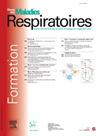Bronchial epithelium energetic metabolism and functionality under exacerbation in childhood asthma
IF 0.5
4区 医学
Q4 RESPIRATORY SYSTEM
引用次数: 0
Abstract
Introduction
Asthma is the most frequent chronic inflammatory disease in children. The main cause of asthma exacerbations is the viral infection of the bronchial epithelium (BE). Rhinoviruses (RV) are detected in 85 % of asthma exacerbations in children knowing that the prevalence of RVC represents 67.5 % in children and associated with severe exacerbations. In adults, it has been shown that BE energetic metabolism shifts from mitochondrial oxidative phosphorylation towards glycolysis compared to healthy BE [1]. In healthy BE, viral infection of BE promotes a metabolic rewiring in favor for glucose utilization through glycolysis rather than mitochondrial metabolism, impacting the muco-ciliary clearance [2]. We suppose that RV infection enhances BE glycolytic metabolism affecting the BE function in childhood asthma. We will analyse both the energetic metabolism and the functions of BE under RV infections on childhood non-asthma and asthma BE.
Methods
Cell culture.
BE cells were obtained from children bronchi fibroscopic brushing. 100 000 cells were seeded on ALI transwell (0.4 μm pores, Corning Incorporated Transwell, Costar) with ALI medium (StemCell) at basal pole.
RV infection.
We infected BE with RVC MOI 0.1. The mix was removed 1 h after and the experiences were realized 24 h after infection.
Cellular oxygen consumption rate (OCR).
OCR was measured on intact cells at 37 °C in a 2 mL thermostatically monitored chamber (2.5 × 105 cells/mL/run) using an Oroboros O2k instrument (Oroboros Instruments).
Ciliary beating frequency.
Ciliary beating frequency of BE were measured using videomicroscopy Leica DMi8 (Leica Microsystems) coupled to a high-speed camera sCMOS Flash 4.0 camera (Hamamatsu) available at The Bordeaux Imaging Center. Using MATHLAB program, the images were analyzed after application of the Fourier transform to determine the most represented beat frequency.
Results
Under basal condition, asthmatic children BE were metabolically different from non-asthmatic children BE. Proteomic analysis, OCR and glycolytic enzymes expression indicated that asthmatic BE were using more glucose through glycolysis rather that mitochondrial metabolism. RV infection aggravate the shift within non-asthmatic BE. In association, we observed a defective ciliary beating frequency and efficiency in asthmatic children BE compared to non-asthmatic children BE.
Conclusion
Our study revealed that non-asthmatic and asthmatic children BE appeared metabolically different, in basal conditions but also after RV infection. BE barrier functions seemed less efficient in asthmatic children BE compared to non-asthmatic BE. To go further, we will deepen how RV infection can modulate energetics and how it will affect BE functions.
儿童哮喘加重时支气管上皮的能量代谢和功能
哮喘是儿童最常见的慢性炎症性疾病。支气管上皮(BE)的病毒感染是哮喘加重的主要原因。在85%的儿童哮喘加重中检测到鼻病毒(RV),已知RVC的患病率在儿童中占67.5%,并与严重加重相关。在成人中,研究表明,与健康的BE相比,BE的能量代谢从线粒体氧化磷酸化转向糖酵解。在健康的BE中,BE的病毒感染促进代谢重组,有利于通过糖酵解而不是线粒体代谢来利用葡萄糖,从而影响粘膜纤毛清除[2]。我们推测RV感染增强了BE糖酵解代谢,影响了儿童哮喘BE的功能。我们将分析RV感染儿童非哮喘和哮喘BE的能量代谢和功能。MethodsCell文化。从儿童支气管纤维镜下刷取BE细胞。10万个细胞在ALI transwell (0.4 μm孔,Corning Incorporated transwell, Costar)上接种,基极为ALI培养基(StemCell)。RV感染。我们用RVC MOI 0.1感染了BE。1 h后取出混合物,24 h后进行实验。细胞耗氧量(OCR)。使用Oroboros O2k仪器(Oroboros Instruments),在2ml恒温监测室(2.5 × 105个细胞/mL/次)中,在37°C下对完整细胞进行OCR测量。纤毛跳动频率。使用Leica DMi8 (Leica Microsystems)视频显微镜和波尔多成像中心提供的高速sCMOS Flash 4.0相机(Hamamatsu)测量BE纤毛跳动频率。应用傅里叶变换后,利用MATHLAB程序对图像进行分析,确定最具代表性的拍频。结果在基础条件下,哮喘患儿与非哮喘患儿在代谢方面存在差异。蛋白质组学分析、OCR和糖酵解酶表达表明哮喘BE通过糖酵解而非线粒体代谢消耗更多的葡萄糖。RV感染加重了非哮喘BE内的转移。与此相关,我们观察到哮喘儿童与非哮喘儿童相比,有缺陷的纤毛搏动频率和效率。结论非哮喘和哮喘BE患儿在基础条件和RV感染后均表现出代谢差异。与非哮喘BE相比,哮喘BE的屏障功能似乎效率较低。进一步,我们将深化RV感染如何调节能量学以及它如何影响BE功能。
本文章由计算机程序翻译,如有差异,请以英文原文为准。
求助全文
约1分钟内获得全文
求助全文
来源期刊

Revue des maladies respiratoires
医学-呼吸系统
CiteScore
1.10
自引率
16.70%
发文量
168
审稿时长
4-8 weeks
期刊介绍:
La Revue des Maladies Respiratoires est l''organe officiel d''expression scientifique de la Société de Pneumologie de Langue Française (SPLF). Il s''agit d''un média professionnel francophone, à vocation internationale et accessible ici.
La Revue des Maladies Respiratoires est un outil de formation professionnelle post-universitaire pour l''ensemble de la communauté pneumologique francophone. Elle publie sur son site différentes variétés d''articles scientifiques concernant la Pneumologie :
- Editoriaux,
- Articles originaux,
- Revues générales,
- Articles de synthèses,
- Recommandations d''experts et textes de consensus,
- Séries thématiques,
- Cas cliniques,
- Articles « images et diagnostics »,
- Fiches techniques,
- Lettres à la rédaction.
 求助内容:
求助内容: 应助结果提醒方式:
应助结果提醒方式:


